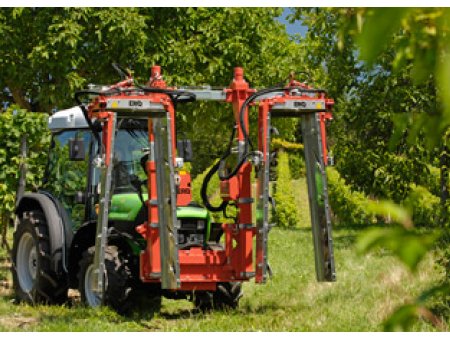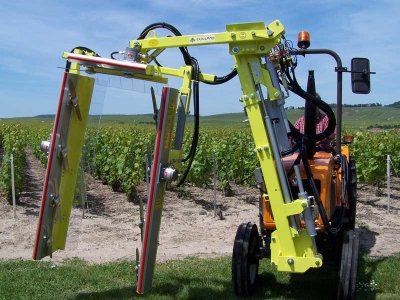Vine trimmer
Trimming takes place after the lifting operations. The height and width of trimming define the size of the vegetation on the row and make it easier for the machinery to pass over. But trimming also has other functions:
- to remove the youngest leaves, which are the most susceptible to fungal diseases,
- to keep the shoots upright,
- to improve the fruit set rate when trimming is carried out at the height of flowering.
Late trimming that is too severe can have harmful effects, as it reduces the leaf area available for berry nutrition.
Trimmers, also known as pruners, are essential for vineyard management.
- to remove the youngest leaves, which are the most susceptible to fungal diseases,
- to keep the shoots upright,
- to improve the fruit set rate when trimming is carried out at the height of flowering.
Late trimming that is too severe can have harmful effects, as it reduces the leaf area available for berry nutrition.
Trimmers, also known as pruners, are essential for vineyard management.

Components of the vine trimming machine
The mast

Mast of a Collard trimming machine
This provides the link between the machine and the tractor.
- The simplest masts are single-beam masts installed at the front or between the wheels.
- The most sophisticated are installed at the front of the tractor, fitted with a parallelogram. The tool can then be moved in front of the tractor, limiting the space required for road travel.
Cutting systems
Several systems are available: reciprocating or rotary. The rotary system with knives is the most widely used.Rotary systems
- Single blade
- Counter-knives
Alternative systems
- Single cutting bars
- With double cutting bars
Trimmer settings and use
A wide range of settings are available, depending on the configuration of the machine.Height
The height of the trimming machine must be adjusted to obtain a sufficient height of foliage (between 0.6 and 0.8 times the inter-row spacing).
As a general rule, the trimming height should not be too low (risk of damage to the knives by the trellising), nor too high (more than 50 cm above the trellising head wire) in order to correctly maintain the branches of certain grape varieties with a drooping growth habit.

Vine trimmer - Provitis
Vertical element spacing
Rarely changed, this setting determines the thickness of the foliage.Row alignment
Tilt
All these adjustments are assisted by hydraulic cylinders.Use
Numerous configurations are possible, in full-row or ½ row, single-row or double-row versions.Front-mounted or in-between-wheels versions are preferable, as they can be used for combined work.
Examples of different trimmers.

Double row trimmer

Half-row trimmer
